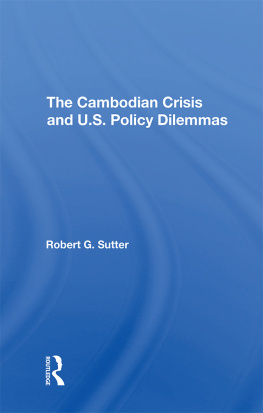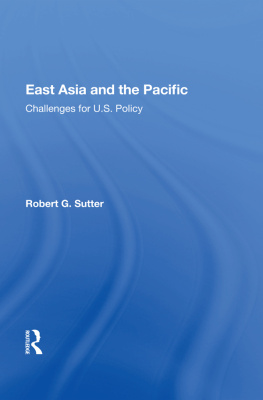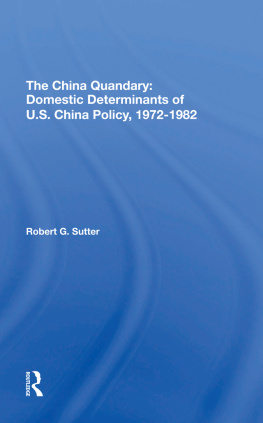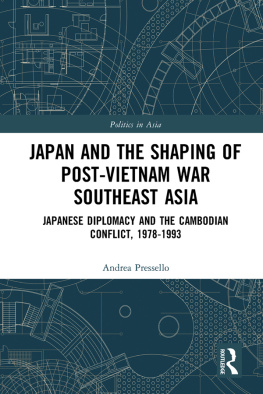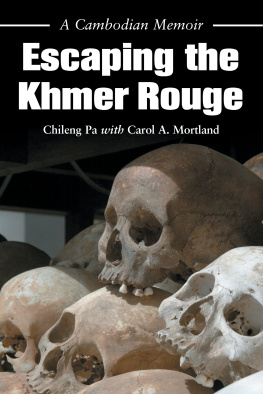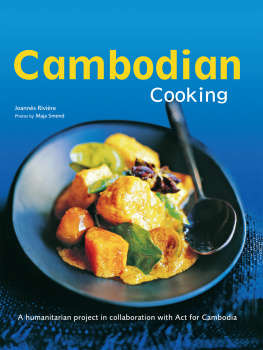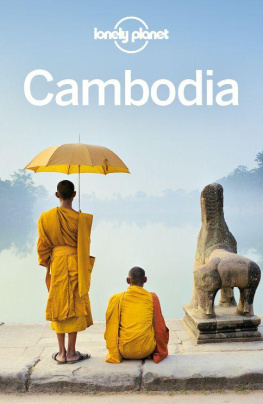Robert G. Sutter - The Cambodian Crisis and U.S. Policy Dilemmas
Here you can read online Robert G. Sutter - The Cambodian Crisis and U.S. Policy Dilemmas full text of the book (entire story) in english for free. Download pdf and epub, get meaning, cover and reviews about this ebook. City: New York, year: 2019, publisher: Routledge, genre: Science / Politics. Description of the work, (preface) as well as reviews are available. Best literature library LitArk.com created for fans of good reading and offers a wide selection of genres:
Romance novel
Science fiction
Adventure
Detective
Science
History
Home and family
Prose
Art
Politics
Computer
Non-fiction
Religion
Business
Children
Humor
Choose a favorite category and find really read worthwhile books. Enjoy immersion in the world of imagination, feel the emotions of the characters or learn something new for yourself, make an fascinating discovery.
- Book:The Cambodian Crisis and U.S. Policy Dilemmas
- Author:
- Publisher:Routledge
- Genre:
- Year:2019
- City:New York
- Rating:5 / 5
- Favourites:Add to favourites
- Your mark:
- 100
- 1
- 2
- 3
- 4
- 5
The Cambodian Crisis and U.S. Policy Dilemmas: summary, description and annotation
We offer to read an annotation, description, summary or preface (depends on what the author of the book "The Cambodian Crisis and U.S. Policy Dilemmas" wrote himself). If you haven't found the necessary information about the book — write in the comments, we will try to find it.
The Cambodian Crisis and U.S. Policy Dilemmas — read online for free the complete book (whole text) full work
Below is the text of the book, divided by pages. System saving the place of the last page read, allows you to conveniently read the book "The Cambodian Crisis and U.S. Policy Dilemmas" online for free, without having to search again every time where you left off. Put a bookmark, and you can go to the page where you finished reading at any time.
Font size:
Interval:
Bookmark:

52 Vanderbilt Avenue, New York, NY 10017
Product or corporate names may be trademarks or registered trademarks, and are used only for identification and explanation without intent to infringe.
Sutter, Robert G.
The Cambodian crisis and U.S. policy dilemmas/Robert G. Sutter.
p. cm.(Westview special studies on South and Southeast Asia)
Includes index.
ISBN 0-8133-8047-2
1. CambodiaPolitics and government1975 . 2. United States Foreign relationsCambodia. 3. CambodiaForeign relations United States. 4. United StatesForeign relationsVietnam.
5. VietnamForeign relationsUnited States. 6. United States Foreign relations1989 . I. Title.
DS554.8.S87 1991
327.730596dc20 90-13015
CIP
- vii

Introduction
- What are the most effective means for the United States to follow in order to curb the supply of weapons to the Khmer Rouge, or to otherwise insure that these Cambodian communists are not allowed to return to a dominant position of power in Cambodia?
- Should the United States strengthen the influence of the two noncommunist resistance forces that maintain a loose alignment with the Khmer Rouge against the Vietnamese-backed communist government in Phnom Penh?
- What is the effect on U.S. influence in the Cambodian situation of the absence of normal U.S. relations with Vietnam? What are the pros and cons of normalizing relations with Hanoi and what are the main procedures that would have to be considered in such normalization of relations?
- What is the appropriate U.S. policy toward China, the Soviet Union, Japan and other powers in regard to a Cambodian settlement? Is there possible common ground among them that could help to foster a settlement that would be in the interests of the United States? Is the United Nations or some other forum appropriate for these powers to meet to discuss Cambodia?
- How do U.S. policy interests in a Cambodian settlement and possible normalization of relations with Vietnam fit in with broad U.S. economic and humanitarian concerns including resolution of longstanding interests over U.S. prisoners of war and missing in action (POWs/MIAs) from the Vietnam War and the large refugee populations coming from Vietnam and Cambodia?
Font size:
Interval:
Bookmark:
Similar books «The Cambodian Crisis and U.S. Policy Dilemmas»
Look at similar books to The Cambodian Crisis and U.S. Policy Dilemmas. We have selected literature similar in name and meaning in the hope of providing readers with more options to find new, interesting, not yet read works.
Discussion, reviews of the book The Cambodian Crisis and U.S. Policy Dilemmas and just readers' own opinions. Leave your comments, write what you think about the work, its meaning or the main characters. Specify what exactly you liked and what you didn't like, and why you think so.

